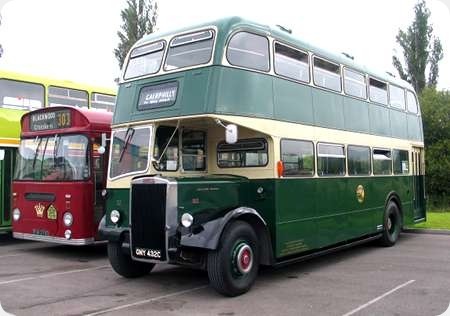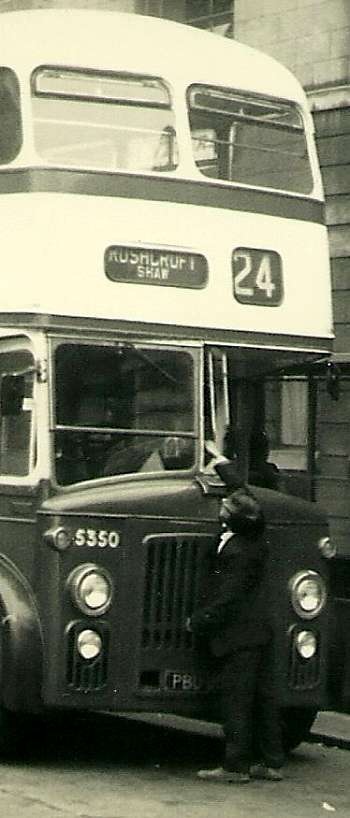Caerphilly UDC – Leyland Titan – GNY 432C – 32
Caerphilly Urban District Council
1965
Leyland Titan PD3/4
Massey L35/33RD
Here we have another Urban District Council vehicle this time it is a Massey lowbridge-bodied Leyland Titan PD3/4 which was new to Caerphilly Urban District Council in October 1965 as fleet number 32. With chassis number L42817 and body number 5911 this bus looks in fine fettle in this photograph, taken at the Bus & Coach Wales event in September 2014.
Photograph and Copy contributed by Les Dickinson
21/01/16 – 06:49
What a smart looking bus. Very unusual to have hopper windows in the saloons of a bus of that age – wonder if they are a later fitment? Must be ‘pretty adjacent’ to the nearside top deck passengers heads – wonder if an additional notice is required ‘Please mind your head on the windows when leaving your seat’!!
Ian Wild
21/01/16 – 06:49
Nice view, Les, and thanks for posting.
Pete Davies
21/01/16 – 07:33
Caerphilly had hopper vents on all their later PD2s and PD3s as well as their Massey-bodied Leopards. They seem to have had some popularity in South Wales as Pontypridd also specified them on their last two Guy Arabs and first few Regent Vs as well as some Reliances at the same time. Oddly, they went back to sliders for the last Regent Vs.
David Beilby
21/01/16 – 15:37
Something curiously old fashioned about it for its age. Probably the trad Massey body and classic radiator- and the blind masks and handle… but how come the OMO-ish cab side windows? Smart job, though.
Joe
22/01/16 – 06:14
Very handsome bus, but what really is old-fashioned about it is that as late as 1965 someone thought it worth ordering a traditional lowbridge bus with the awful offside sunken gangway on the upper deck.
David Wragg
22/01/16 – 06:15
Joe – you’ve lost me there about "OMOish cab side windows ?? The extended destination handles were not unknown amongst certain operators and they were an extremely good idea – any small conductor/driver, or any height for that matter, could have a nasty accident climbing up a slippery metal foothold to change the destination in the more usual arrangement. As you say curiously old fashioned – but in my view delightfully traditional and oh how I wish they were rolling off the production lines in their hundreds today !!
Chris Youhill
22/01/16 – 16:10
Talking of small Conductors and changing destination blinds, here is an Oldham Corporation Passenger Transport Department ‘GUARD’ doing just that with the help of the extended winding handles, on Roe (H37/28R) bodied Leyland PD2/30, PBU 950 (Fleet No.450).
New in October 1958, it passed to SELNEC PTE in November 1969, and was given Fleet No.5350, a seen here.
It was the only bus to carry the SELNEC fleet number on the Crimson Lake livery.
It was withdrawn in July 1971, and went to Barnsley for scrap.
Stephen Howarth
22/01/16 – 17:04
West Riding were partial to long winding gear as were Salford. In Salford it was specifically to stop crews clambering up the bus front. Of course West Riding went one further so to speak by fitting exterior winding gear to their Wulfrunians!
Chris Hough
23/01/16 – 06:45
Chris Y…. OMOish because the drivers engine side window appears to be in two pieces but not angled enough for fares… Or was there an orderly queue up, the bus?! Any ideas anywhere… And Chris….were those or the Regent V at Ledgards the only survivors into West Yorkshire?
Joe
23/01/16 – 06:46
David W – Purely by chance, I came across an item about the last lowbridge-bodied bus built – in 1968 and preserved. Coincidentally it was also a PD3 with Massey body! It was bought by Bedwas & Machen UDC, who worked closely with Caerphilly and the two probably influenced each other.
See: //historypoints.org/index.
Chris Hebbron
23/01/16 – 06:47
I don’t think the hopper vents would have been a problem for passengers leaving, since it was impossible to stand up in any case. The only way out was to slide along the seat – after asking anyone else who was on it to unload themselves into the gangway first.
There really was no excuse for this in 1965. I know these buses were wonderful for enthusiasts, but passengers and conductors were more important.
Peter Williamson
23/01/16 – 12:43
No Joe – you can definitely forget any OMO connotation on connection with the cab window. I’m pretty certain that the only front engined buses, and forward entrance ones at that, were some adapted by various operators for the purpose by angling the front bulkhead window partly over the bonnet. It was the shabbiest practice ever and involved the driver twisting round excessively to serve boarding passengers on the steps as they entered. Much unjustified scoffing is aimed at "Health and Safety" but this would be a prime example of where this "OMO" practice should have been stamped on from the very start !!
Now, the West Yorkshire/Ledgard takeover – all the Ledgard vehicles were taken over by West Yorkshire, but only fourteen were used by them. These were the ten AEC Regent Vs (six new to Ledgard and four ex South Wales) which became DAW 1 – 10, and the two Daimler CVG6s which became DGW 11/12. This apparent "series" of 1 – 12 was not a series but a coincidence as West Yorkshire already DGW 1 – 10 of their own, those being Bristol KSW6Gs. Also used by West Yorkshire were Ledgard’s two Thames/Duple coaches which became CF1/2.
Chris Youhill
25/01/16 – 06:31
Thank you, Chris Hebbron. I hadn’t realised that lowbridge bodies were produced as late as that. My family left for Malta for three years in 1956, by which time Hants & Dorset Bristol LD series Lodekkas could be seen in Gosport. Of course, the change over took some time, and returning in 1959 there were still lowbridge Bristol Ks running around Gosport and Fareham, as well as a couple of highbridge convertibles that had originally been panted in reversed out livery and which, with the upstairs roof on, rattled like mad.
David Wragg
26/01/16 – 06:46
The specifying of lowbridge bodywork as late as 1965 and even afterwards indicates organisations in which the purchasing decisions were dominated by the engineering department. Better to have a simple, proven traditional chassis like the PD3 rather than one of those troublesome rear engined things. As far as the passengers were concerned, they were used to the old lowbridge type and didn’t know any better. The fundamental reason for running buses – that of encouraging people to travel by offering an attractive mode of transport – didn’t enter the equation. The Lodekka was still available right up to 1968, but that didn’t have a rear entrance, nor could it have a Massey body. This was surely a case of "It’s always been done; why change?".
Roger Cox
29/01/16 – 07:09
Does anyone know why, after decades of running lowbridge dds, Caerphilly suddenly switched to highbridge for their last two PD2s (F-reg) and subsequent Atlanteans?
David Call
30/01/16 – 06:10
I think the main reason that Caerphilly changed was the removal of a low railway bridge at Maes-y-Cymmer, between Ystrad Mynach and Pontllanfraith. This was on two routes – the famous 36 from Cardiff to Tredegar and also the former Commercial Motor Service route from Pontypridd to Blackwood. As a consequence it had an impact on a lot of fleets as Cardiff, Caerphilly and West Mon worked the 36 whilst the other service involved Caerphilly, Pontypridd and West Mon. Pontypridd also had a works journey to Pontllanfraith and for this reason Pontypridd had two lowbridge K6Gs in an otherwise highbridge fleet.
Cardiff’s contribution was lowbridge Crossleys followed by Bridgemasters. I think there was another low-ish bridge which still constrained Cardiff a little and only certain batches of vehicles appeared on the 36 even when the Maes-y-Cymmer bridge was removed.
David Beilby
25/10/16 – 14:22
Ramsbottoms last two PD3s, 10 and 11, were fitted for OMO by having an angled shelf towards the driver but when they were transferred to Bury after the Selnec takeover, the crews there would not entertain it at all.
David Pomfret
Quick links to the - Comments Page - Contact Page - Home Page
Comments - Please note: The comments facility is not currently available. Please see the home page for updates.
Please Note if you want to send a photograph with your comment please use the Contact Page by clicking here or send as an attachment via email.


